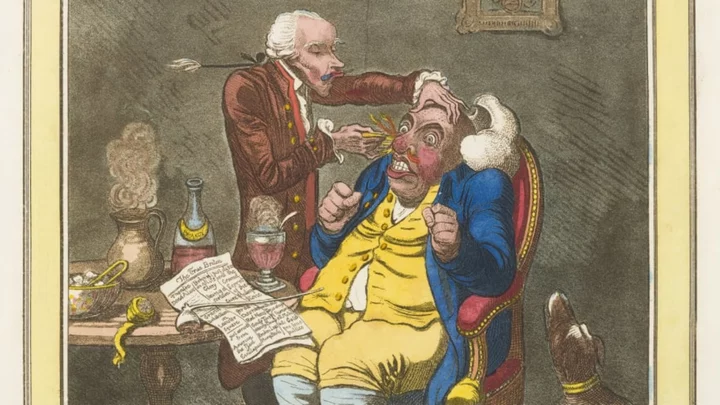For as long as there have been gullible people, there have been charlatans eager to take advantage of them—and even famously great minds, like the first U.S. president, have been known to fall for their smoke, mirrors, and snake oil. According to Merriam-Webster, a charlatan is a quack known for making ”showy pretenses to knowledge or ability.“ The Oxford English Dictionary lists the original French term as synonymous with “a mountebanke, [...] a pratling quack-salver, a tatler, [and a] babler.” Whether they were hawking miracle medical cures or pictures of ghosts, these con artists made history with their scams.
1. Elisha Perkins
Elisha Perkins’s quack miracle cure didn’t involve mystery tonics or questionable surgeries. To treat rheumatism, gout, and other ailments, the doctor prescribed rubbing two pieces of metal over the afflicted area. His patented “Perkins Metallic Tractors” consisted of one pointed brass rod and one iron one. Anyone with money to buy the tractors could administer the treatment to themselves, and it quickly swept post-revolutionary America—even President George Washington bought a set. Perkins’s rods may not have had any real medical value, but they did hold scientific significance. Research from 1799 found that subjects were just as likely to report feeling “cured” by the tractors as they were by other pointed objects that weren’t made of metal—one of the earliest examples of the placebo effect in a scientific study.
2. William Mumler
Photography was still a relatively new technology when the Spiritualist movement took off in the mid-19th century, and American photographer William Mumler took advantage of the craze to sell people glimpses of their lost loved ones from beyond the grave. Customers would pay up to $10 (an average week's earnings for many skilled workers) to pose for portraits and receive prints that showed faded figures standing next to them. In a time when the country was still grieving the staggering loss of the Civil War, business boomed.
Mumler didn’t claim to understand the supernatural forces at play and never guaranteed that ghostly visitors would crash his shoots. Despite his ignorant act, his work garnered the attention of skeptics, and in 1869 he was arrested and tried for fraud. Persecutors claimed that it was possible to create such images using common photo manipulation techniques like double exposures or superimposed negatives. They were unable to come up with one definitive explanation for his trick, however, and Mumler was ultimately acquitted. His reputation wasn't fully tarnished by the scandal: At the end of his career, he photographed First Lady Mary Todd Lincoln with what he claimed to be the spirit of her late husband Abraham.
3. Mary Baker
It didn’t take much to convince the British public you were foreign royalty in 1817. When Mary Baker stumbled onto the streets of Almondsbury wearing exotic garb and speaking a made-up language, she quickly caught the attention the local townsfolk. Via a Portuguese sailor “translator,” she explained she was the lost Princess Caraboo of the (made-up) island of Javasu in the East Indies. Her performance was authentic enough to fool her hosts, and soon scholars and artists were coming to watch her show off her dancing, fencing, and archery skills. Princess Caraboo gained enough fame to have her story printed in the paper. Her charade, however, didn’t last long: The owner of a nearby lodging house recognized her as a former guest who entertained her children by speaking in made-up languages. Mary was exposed as a mere cobbler’s daughter and a fraud, but her acting talents didn’t go unappreciated—she eventually traveled to Philadelphia, where she entertained Americans with her fake princess act.
4. Amy Bock
In the early 20th century, Amy Bock became the first woman to be classified as a habitual criminal by New Zealand. Her self-proclaimed kleptomania drove her to a lifetime of petty scams, with her most famous crime involving her male alter-ego Percy Redwood. The character she constructed was a charming sheep farmer with impressive familial connections. In 1909, she conned a woman in her thirties, Agnes Ottaway, into marrying Percy with promises of a generous cash gift from her future mother-in-law (who conveniently couldn’t make it to the ceremony). Amy was found out and arrested just four days later, and ultimately pled guilty to false pretenses and forgery. She was sentenced to four years of hard labor. Her criminal tendencies didn’t stop there, though: She continued to scam people and fool them into thinking she was someone she wasn’t into her old age. She made her final court appearance at age 72, but none of her later crimes were serious enough to land her back in prison following the Percy Redwood incident.
5. John Brinkley
It takes a skilled charlatan to make an operation that involves sewing goat testicles into your scrotum sound like a good idea. That’s exactly what John Brinkley did in the 1920s and ‘30s. The quack doctor claimed that the testicular glands of young goats could cure impotence when surgically attached directly to the source of the problem. He told patients he would connect the goat testicles to their reproductive system so the animals’ glands would continue to function, when in reality he was simply sticking them in loose just beneath the skin. This obviously did nothing to help men’s troubles, but his convincing salesmanship helped him avoid scrutiny. He used radio to advertise his ideas to the mass market, often to the ire of the Federal Radio Commission.
Brinkley’s scam eventually spread wide enough to earn the attention of the American Medical Association, who spent years trying to expose his fraudulence. Brinkley sued the AMA’s Morris Fishbein for libel in 1939, but this did little to help his case. In court it came to light that his medical degree had come from a diploma mill, and the AMA’s characterizations of him proved accurate. He spent the last several years of his life enduring government investigations and malpractice lawsuits before dying of heart failure in 1942.
6. Charles Ponzi
In 1920, Italian American immigrant Charles Ponzi devised a scam big enough to get a new term named after him. Because of an international treaty, postal reply coupons purchased in other countries and mailed to the United States could be exchanged for U.S. postage stamps worth a nickel. Ponzi realized he could profit off the system by getting people he knew in Europe to send him international reply coupons from countries where the dollar was weak, exchange them in the U.S., and then sell the 5-cent stamps for their full American value. This technically-legal operation became a classic Ponzi scheme when he invited investors to get in on his business, promising their money back plus 50 percent interest in just three months. Charles Ponzi cheated investors out of $20 million by keeping most of the money for himself and using incoming investments to pay off the old ones.
He wasn’t the first person to use such shady tactics—others, like Sarah Howe, ran similar schemes in the mid- to late-19th century—but he will forever be associated with the Ponzi schemes that came after him. The federal government got wise to Ponzi’s racket and charged him with mail fraud in 1920. He served three-and-a-half years in prison for the federal charges, plus nine years for the state charges that came later.
7. Clark Stanley
Snake oil wasn’t always synonymous with scam products. Oil made from Chinese water snakes had long been used in China as a topical treatment for arthritis and other conditions caused by inflammation. When Chinese rail workers brought the medicine with them to the U.S. in the 19th century, the name took on a new meaning. Clark Stanley, a.k.a. “The Rattlesnake King,” is regarded as America’s first snake oil salesman. He marketed his “Snake Oil Liniment” as a cure-all for pain, but it didn’t live up to the original Chinese remedy. It didn’t even come from real snakes; federal investigators analyzed his product in 1917 and found it consisted of mineral oil, fatty oil likely from beef, red pepper, and turpentine. Shortly after that, the fraudster “snake oil salesman” became a common archetype in media. Stanley was fined $20 for his deception.
8. Norman Baker
Quack doctor Norman Baker promised his patients miracle cancer treatments that contradicted mainstream medical practices in the 1920s and ’30s. His first cancer facility, the Baker Institute at Muscatine, attracted desperate clients and shady practitioners who were otherwise unemployable. In the late 1930s, he set his sights on the Crescent Hotel in Arkansas. Under his ownership, the historic hotel transformed into a ”clinic“ that promised to cure cancer patients using groundbreaking, non-invasive methods. Though his treatments were bogus, he managed to swindle millions of dollars from his guests.
In addition to being a sham doctor, he was also a lousy hotel proprietor: In 2019, a landscaper stumbled upon a hoard of medicine bottles that Baker and his cohort filled with tissue—possibly cancer tissue—and buried on the property. The American Medical Association eventually caught wind of his shoddy practices, and in 1940 Baker was convicted of mail fraud and sentenced to prison. He was released after just three years.
This article was originally published on www.mentalfloss.com as 8 of History’s Greatest Charlatans.









